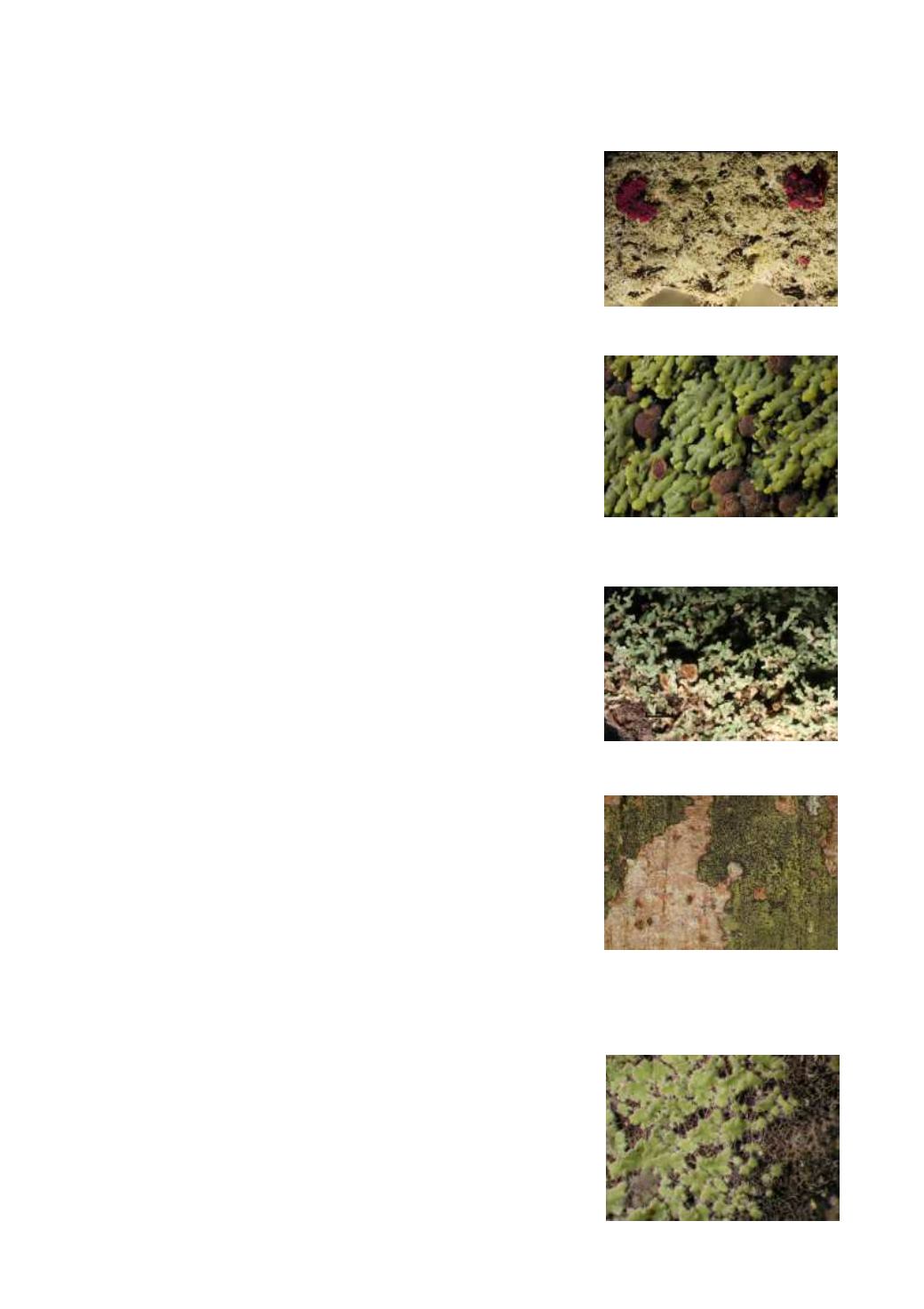
75
Phyllopsora borbonica
Timdal & Krog
Thallus crustose, formed of small, adnate, isodiametric areolae developing on a
black hypothallus. Areolae discrete to adjoined peripherally, forming a more or
less continuous crust centrally, pale green and glabrous, sometimes pubescent
only along the margins. Isidia absent. Apothecia abundant, up to 2 mm in
diameter, without a thalline margin, rounded, simple, plane to moderately
convex, reddish brown. Spores colourless, 1-celled, acicular. Photobiont:
chlorococcoid. Spot-tests: all negative. - Rather rare on trunks of mature trees in
very humid forests above 1300 m (Nuwara Eliya and Adam's Peak trail).
Phyllopsora breviuscula
(Nyl.) Müll.Arg.
Thallus squamulose, developing on a thick, reddish brown prothallus, forming
incomplete circular patches. Squamules large, adnate, elongated, contiguous or
partly imbricate, soon becoming deeply divided, distinctly convex, medium
green or often with brown patches. Isidia and soredia absent. Apothecia
common, without a thalline margin, rounded, simple or conglomerate, plane to
moderately convex, medium brown, with a paler and indistinct proper margin.
Spores broadly ellipsoid to fusiform, colourless, 1-celled. Photobiont:
chlorococcoid. Spot-tests: all negative. - Very common on the trunks of mature
trees in very humid forests above 1000 m (Central Highlands, high elevation
rain forests and along rocky stream margins of sub montane and montane
forests).
Phyllopsora confusa
Swinscow & Krog
Thallus squamulose, developing on a thin, but often well developed, white to
partly reddish brown prothallus. Squamules small, narrow, ascending, lacinulate
and imbricate, plane to weakly convex, bluish green to green, glabrous or finely
hairy along the margins. Isidia absent but lacinules often coralloid. Apothecia
non lecanorine, rounded to irregular, simple, plane to moderately convex, pale
to medium brown. Spores colourless, ellipsoid to shortly bacilliform, 1-celled.
Photobiont: chlorococcoid. Spot-tests: all negative. - A pantropical species,
found in humid rain forest and humid submontane areas (Avissawella,
Nawalapitiya, Hatton and Knuckles mountain range).
Phyllopsora furfuracea
(Pers.) Zahlbr.
Thallus crustose areolate, effuse, formed by the prothallus and: 1) partly by
minute round to irregular, more or less contiguous areolae, sometimes appearing
as a continuous crust, and, 2) partly by isidia developing directly from the
prothallus; isidia usually dominating. Prothallus white to reddish brown.
Areolae c. 0.05–0.10 mm wide, adnate, more or less isodiametric, plane to
weakly convex, medium to dark green, glabrous or rarely pubescent along the
margins. Isidia usually abundant, moderately thick, subglobose to cylindrical,
medium to dark green, often with a brown tinge, glabrous, simple to coralloid,
often curved, decumbent to ascending. Apothecia common (but not seen in Sri
Lankan material), to 2 mm wide, irregular in outline, usually conglomerate, convex, pale brown to dark reddish brown.
Spores colourless, narrowly ellipsoidal, 1-celled. Photobiont: chlorococcoid. Spot-tests: all negative. - Found in humid
rain forest and humid submontane areas (Avissawella, Nawalapitiya and Hatton).
Phyllopsora kiiensis
(Vain.) Gotth. Schneid.
Thallus squamulose, developing on a conspicuous reddish brown prothallus.
Squamules pale green, medium sized, adnate, scattered when young, later
contiguous, crenulate to incised, plane to weakly convex, glabrous on upper
side, pubescent along the margins. Isidia usually abundant, attached marginally
to the squamules, often long, simple to slightly branched. Apothecia rare (not
seen in Sri Lankan material), to 2 mm diam., of irregular shape, pale brown.
Spores colourless, ellipsoid to shortly bacilliform, 1-celled. Photobiont:
chlorococcoid. Spot-tests: all negative (furfuracein). - Found in dry to humid
rain forest (Ratnapura and Mathugama).


